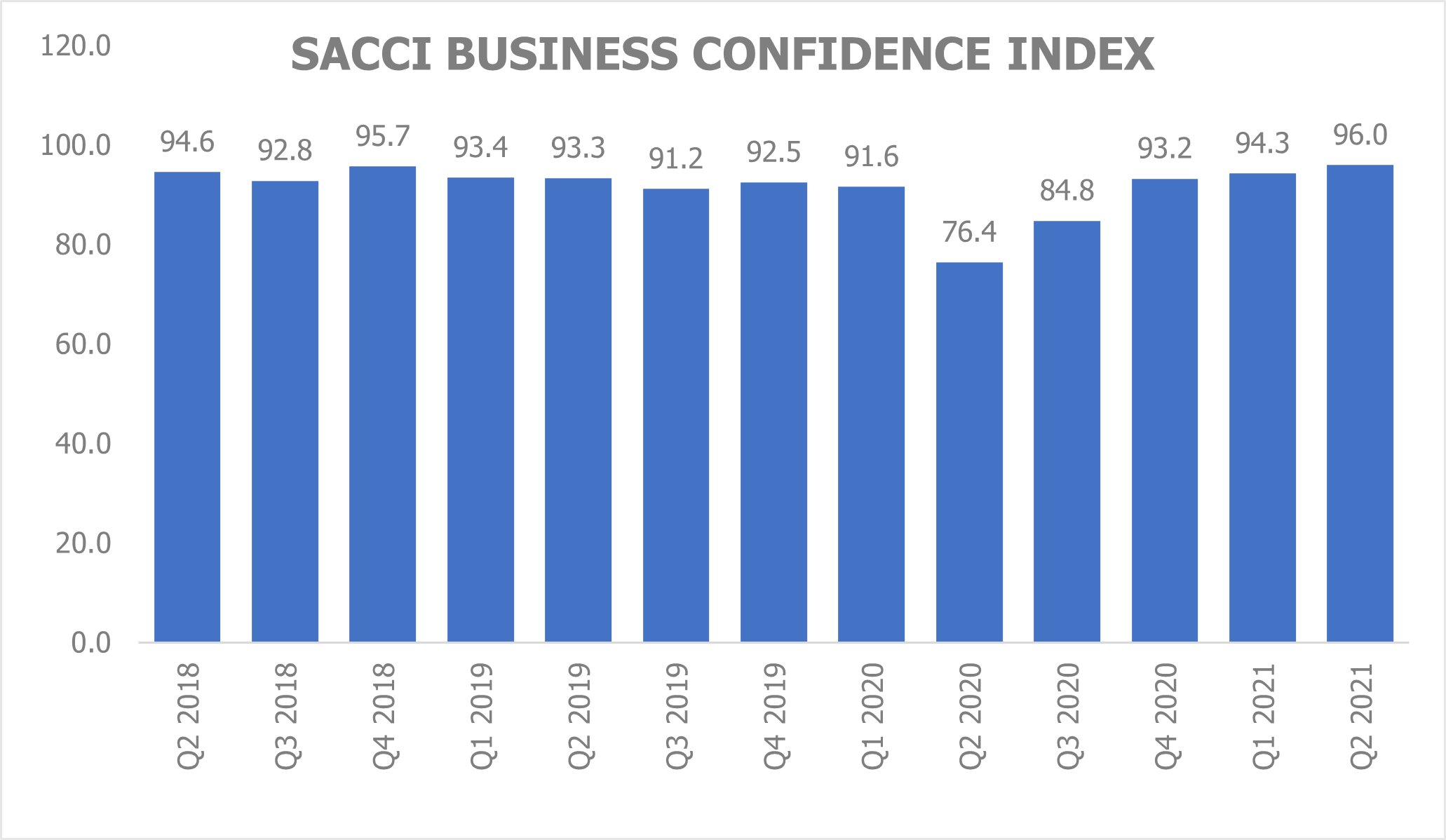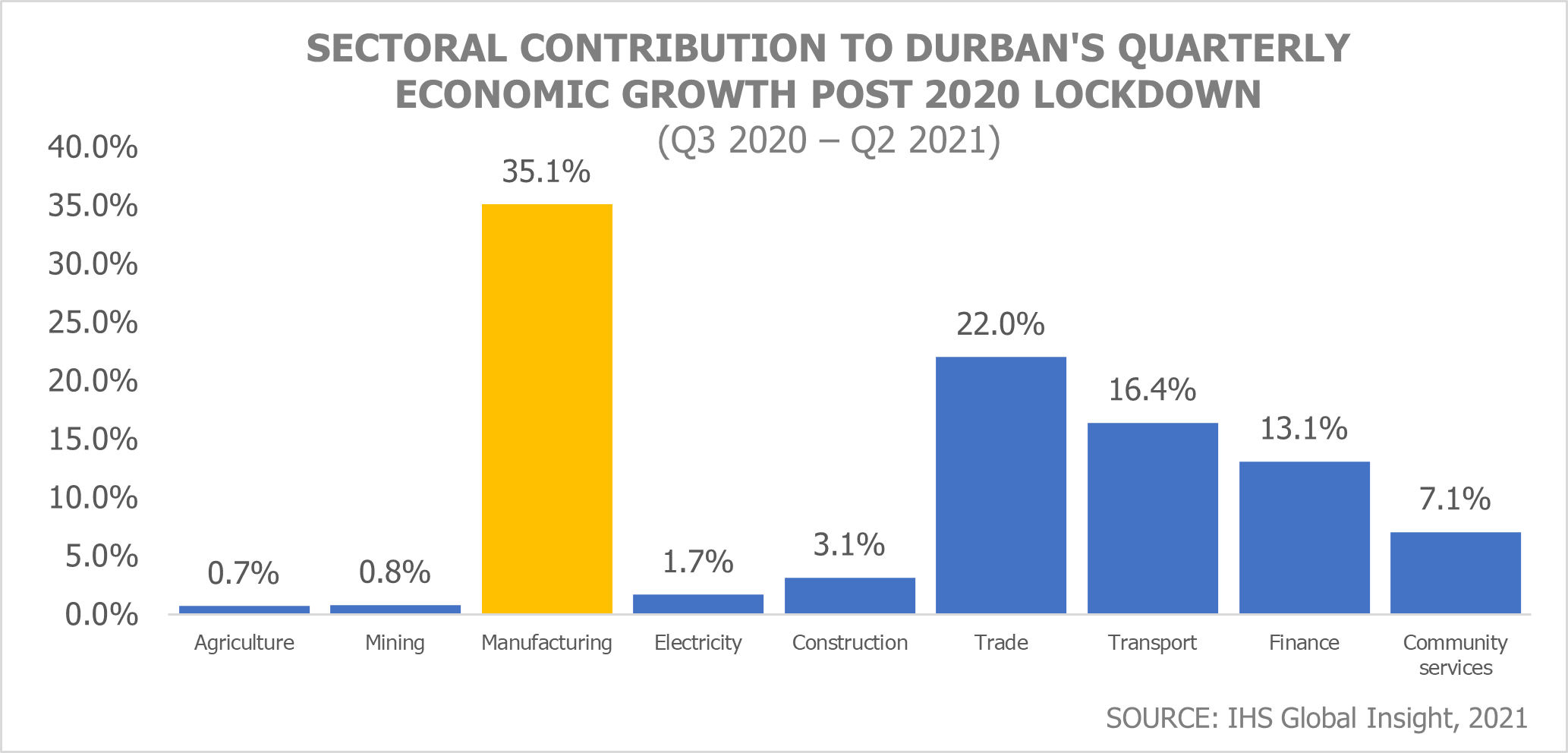
WHAT HAVE BEEN THE DRIVERS OF RECENT POSITIVE ECONOMIC GROWTH IN DURBAN?
Despite repeated negative shocks to South Africa’s economy, some recent economic performance indicators have been surprisingly positive. StatsSA recently recorded a national growth rate of 1,2% in GDP between the months of April and June of 2021, and 1% between the months of January and March 2021. During this same time period, national business confidence rose to its highest level in 13 quarters (since 2018). While this positive performance was experienced before the July 2021 unrest; it is still important to understand the reasons behind this resilience in economic activity.

NATIONAL GDP GROWTH DRIVERS
Growth at the national level can be attributed to a range of factors; including a global commodity boom which lifted national growth; ensuring positive growth rates in the agricultural and mining (due to exports in precious metals) sectors. According to StatsSA, three sectors contributed to almost 80% of South Africa’s positive growth in the second quarter; including the Transport sector (34% of positive growth), the Personal Services sector (26% of positive growth) and Trade Industries (18% of positive growth). As a result of this, as well as three other quarters of positive GDP growth (13,9% in Q3 2020; 2,5% in Q4 2020; and 1,0% in Q1 2021), tax revenue amounted to R377-billion for the period from April to June 2021, an increase of 56.2% on the previous year. Following from this sustained, albeit slow recovery; National Treasury recorded a primary budget surplus for the first time in 3years; meaning more was collected in revenue than what was spent by government nationally. Finally, South Africa was also recorded as having the best performing emerging market currency, assisted by current account surpluses and the global commodity boom.
SLOW, BUT NOTABLE POST LOCKDOWN GROWTH
According to recently published IHS figures, Durban’s economy is estimated to expand at 4,5% in 2021. The City has experienced above average growth right from the first lifting of lockdown restrictions in Q3 2020 (albeit off a low base). However since the initial surge in growth post lockdown; economic activity has begun to normalise and “correct” itself, while growth rates have reverted to fluctuating within the 0,5% - 1% band. As such, the City’s economy grew at 0,5% between January and March in 2021 and further grew at 1,1% between April and June 2021.

WHAT SECTORS HAVE DRIVEN DURBAN’S RECOVERY?
When identifying sectors that have lifted the City out of its Covid19 induced downturn, Manufacturing has emerged as being most significant. Between July2020 and June 2021, it has singularly contributed a quarterly average of 35,1% to Durban’s growth. This is due to its size and an initial growth of this sector by 24,5% after the initial lifting of lockdown restrictions. Additionally, according to the SACCI Trade Conditions Survey, the quarter on quarter percentage increase in monthly values of new orders increased to its highest ever recorded growth (71,1%increase in Q3 2020), since the survey was launched in 2000. This is likely the result of “catch up” orders since restrictions were placed on the manufacturing sector at the start of the pandemic.
Other sectors which have contributed to recovery include Trade (at 22,0%of growth), as well as Transport (at 16,4% of growth). The Trade sector appeared to have achieved notable successes at the national level (in the six months between June and December 2020, The Shoprite Group generated a R4.7bn trading profit; which was 18,3% higher than in 2019, despite alcohol restrictions). This was also the case locally, where RCL Foods recently (headquartered in Westville Durban) reported a return to profit with double digit growth. The Transport sector, the third major contributor to the City’s GDP growth, is inextricably linked to Manufacturing and Trade, and may therefore have benefitted from the increase in export activity as well as increased domestic orders.
Finally, at a contribution of 1,7%, the Electricity sector displayed minimal economic growth. While this is an ongoing cause for concern, the Renewable Energy sector represents another area of potential with the City having put out calls for Independent Power Producers to submit quotations to the value of 400MW. This is attracting significant interest; however the impact of this on there liability of energy supply is yet to be seen.

CONCLUSION
The City and country have undoubtedly been affected by the Covid19 pandemic. However, with the exception of the July 2021 unrest, the economy has remained resilient in maintaining positive growth since the first lifting of lockdown restrictions. Key drivers include Manufacturing, Trade and Transport- all inherently linked sectors. Since then, the unrest has resulted in net economic impact of-R12,8 billion on the City’s economy alone. While it will be important to seethe impact of this on growth and performance, the resilience of Duran and South Africa’s economies are important assets in the development of response and recovery plans.